Resynthesizer von Dave Rossum (Ex-E-Mu)
Dave Rossum und Marco Alpert überraschen uns immer wieder aufs Neue. Jetzt nicht böse sein, liebe Eurorack-Fraktion, aber langsam hätte ich gerne aus all den Modulen von „rossum electro-music“ einen kompletten Synthesizer, bei dem man keine Strippen ziehen muss.
Ich fasse mal zusammen: Da wäre das geniale E-Mu-Filter aus dem E-Mu Modularsystem, ein Sampling-Modul, ein Hammer-Sequencer, das Z-Plane-Filter aus dem E-Mu Morpheus und den E-Mu IV Samplern sowie ein Multi-Oscillator – und nun dieser wunderbare Resynthesizer.
Mal ehrlich, das gäbe doch einen Traumsynthesizer.
Na gut, bin schon leise. Schließlich kann man sich alle mit dem nötigen Kleingeld (… denn die Module von Rossum Electro-Music sind nicht gerade die preisgünstigsten) ins Eurorack schrauben, verkabeln und ebenfalls loslegen – aber …
Rossum Panharmonium Mutating Spectral Resynthesizer
Wir erlauben uns heute ausnahmsweise, die englische Version online zu stellen, da einfach gerade die Zeit für eine Übersetzung fehlt (auch Redakteure haben mal Feierabend). Aus Gründen der Aktualität war uns aber wichtig, dieses heiße Eisen noch schnell online zu setzen. Ich hoffe, ihr habt dafür Verständnis.
Created by Rossum Electro-Music Software Architect Bob Bliss (who also, as it happens, fathered E-mu’s famed “EOS” Emulator Operating System), Panharmonium is a unique music and sound design tool that analyzes the spectral content of any audio signal and uses that analysis to drive a bank of from 1 to 33 oscillators. Depending on various control settings, Panharmonium can accurately reproduce the input spectrum in real time or modify it in a multitude of wildly creative ways. All with an interface whose immediacy encourages performance and interaction.
Panharmonium input can be anything from a single oscillator to an entire mix (including vocals). From dense, swirling pads and drones that evolve with the input’s changing spectrum, to clock-syncable spectral arpeggiation, to as-yet unnamed harmonic effects, Panharmonium opens up an entirely new world of sonic possibilities.
Additionally, Panharmonium can take a snapshot of an instantaneous spectrum and use that as a complex harmonic oscillator, which can then be modified and modulated by all of Panharmonium’s other controls.
Panharmonium accomplishes its magic though a combination of functional submodules:
Spectral Analyzer
The Spectral Analyzer provides tools for defining the analysis process.
- The Slice parameter sets the rate at which the incoming audio is transformed to spectral data. It can be set by the Slice and Multiplier controls, the Tap button, or by an external clock signal. Very short slice times result in real-time spectral data, while longer times can create rhythmic spectral patterns.
- The Center Freq and Bandwidth controls (and associated CV inputs and attenuverters) control the range of frequencies to be analyzed. The Bandwidth control allows the selection of narrow to wide pass bands on the left side of the pot and narrow to wide notches on the right side of the pot. The ability to sweep the frequency and modify the bandwidth under CV control opens up a wide range of sonic effects.
- The Freeze button lets you freeze the spectral integrator, sustaining the currently analyzed spectrum.
Spectral Modifiers
These controls allow the creative modification the analyzed spectra.
- The Voice parameter controls the number of oscillators (from 1 to 33) used to resynthesize the spectrum.
- The Blur parameter (and associated CV input) is a spectral lag processor that controls how quickly the spectrum can change.
- The Feedback control (and associated CV input) allows one to route the resynthesized audio back into the entire processing chain for subtle or dramatic feedback effects. At its max, the output becomes self-sustaining, even if the input is removed.
Oscillator Bank
The Oscillator Bank resynthesizes the analyzed spectra.
- The Waveform parameter selects the oscillators‘ waveform. In addition to the usual sine, triangle, sawtooth and pulse waveforms, two special crossfading sine and sawtooth waveforms are included.
- The Freq control tunes the oscillators over a +/-7 semitone range. The frequency is further controlled by the 1V/Oct input and the FM input and attenuverter.
- The Octave control, not surprisingly, shifts the pitch of the output by octaves.
- The Glide parameter sets the amount of polyphonic glide (i.e., each oscillator has its own glide circuit).
- The Mix control (and associated CV input) sets the balance between the original input audio and the resynthesized audio.
Optional Functions
A number of optional functions can be selected by using the Output Mode and Tap buttons.
- Holding the Output Mode button and adjusting the Slice control enables Drums Mode, which optimizes the spectral analysis for drums and other percussive inputs.
- Holding the Output Mode button and adjusting the Center Freq control allows one to instead set the lower frequency of the analysis range.
- Holding the Output Mode button and adjusting the Freq control enables Spectral Warping. In contrast to conventional frequency adjustment, where the harmonic relationships between the spectral elements are preserved, Spectral Warping shifts the harmonic elements individually, producing a variety of clangorous, swarming textures.
- Holding the Tap button and adjusting the Freq control quantizes the resulting frequency adjustments to semitones.
Spectra Memories and Presets
Panharmonium provides 12 user Spectra memories and 12 user Presets (in addition to 12 each factory memories).
- The Spectra memories let you store up to 12 frozen slices. When selected, a spectrum (up to 33 oscillators wide!) replaces any live input and can have its pitch controlled by the 1V/Oct input and FM controls.
- A Preset is a snapshot of all of the module settings, along with the value of any CVs present at the moment the preset is saved.
- Panharmonium is 26HP wide and 25mm deep.
- Power requirements (max): 140mA +12V, 30mA -12V. Reverse polarity protected.
- Panharmonium will be available in early summer from Rossum Electro-Music dealers worldwide at a suggested retail price in the US of $499.00.



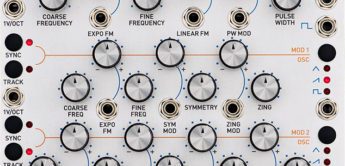
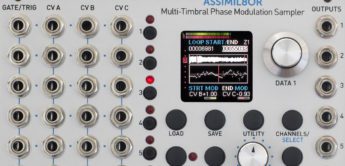


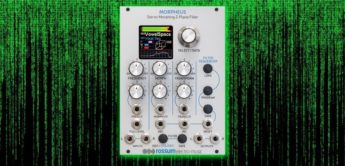
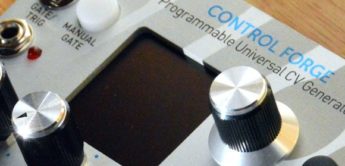
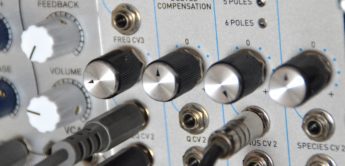

Das würde ich ja gern mal hören was da rein – bzw. Rauskommt im Vergleich. Bis zu 33 Oszillator Top.
Den muss ich erstmal verdauen, der kam wie der Triple-VCO völlig unerwartet… Die Jungs von Rossum Music haben Steve Jobs wahrhaft verinnerlicht: Menschen wissen nicht was sie wollen, bis man es ihnen zeigt.
Wobei ich weiss, dass ich eines Tages das erwähnte Rossum-exklusive System meins nennen werde!
Wow! Knaller! Mussichhören!
Für mich ist Rossum derzeitig der interessanteste Modulhersteller.
Mutating Spectral Resynthesizer – wer braucht da noch einen Sampler? Schon der Assimil8or hat mich sehr neugierig gemacht, aber dieses Teil ist ein ganz anderes Kapitel. Warte schon auf Sounds und Tests; 499,-$ erscheinen mir da auch nicht zu teuer…
Alter, das Teil haben die doch aus nem abgestürzten Raumschiff ausgebaut…
@Coin Kommt mir so vor als verfügen die über irgend welche Alientechnologie…. oder die Jungs von der NASA haben die Finger mit im Spiel…
Hört sich vom Konzept her an wie ein um Oszillatoren erweitertes Mutable Instruments Clouds, das für sich genommen ja schon ein großer Erfolg war. Kombiniert mit den zusätzlichen Features und der hohen (Audio-) Qualität der Rossum-Produkt-Linie wird das bestimmt ein schönes Teil …
Wird gekauft :)
Ich frage mich ob ich es richtig verstanden habe? Spektrum des eingehenden Signal wird analysiert ,33 Oszillatoren versuchen das selbe Spektrum zu generieren wobei es natürlich zu leichten Abweichungen kommt. Nicht ganz klar ist mir die genau Form der Synthese. Evt. Additiv?
Das ganze auch noch in Echzeit, inklusive speicherbare Oszillatoren, unzählige features und Möglichkeiten FM Schweinereien zu betreiben? Dazu noch das bezaubernde Design zu einem fairen Preis?
Ps. „aber langsam hätte ich gerne aus all den Modulen von „rossum electro-music“ einen kompletten Synthesizer„ Absolut! Ein Rossum Synthesizer wäre ein Traum!
Anscheinen wurde das Panharmonium an der Synthplex ausgestellt.
Daher gibt es die ersten Demos auf Youtube.
Leider sind die Aufnahmen nicht die besten, aber es lässt sich bereits erahnen wie vielseitig die Möglichkeiten dieses Moduls sind.
Kann’s kaum erwarten das Prachtstück selbst zu testen!
Sorry Tyrell, für mich aufgrund meiner Erfahrung und dem leider gelöschtem Artikel zum Satellite gehören die Rossum Module nicht mehr zu meinem heißen Eisen. Gerade die Bedienungsanleitung zum Satellite täuscht den Anwender, weil hier vorgegeben wird, dass das Modul alle 500 Presets und die 200 Sequenzen der Control Forge enthält. Irrtum: es sind nur einige Vorlagen geladen, weiter nichts.
Weiterhin fehlt dem Morpheus die Möglichkeit direkten Einfluß auf die Bandpässe zu nehmen. Es gibt nette Cubes, sonst fraglich! Weil, da ist nichts mit dem Zugang zu allen Parametern!
Mein Fazit: es gibt bessere und ehrlichere Module, die zudem auch weniger kosten! Lobpreisungen für Dave Rossum sollten eher im Vergleich mit Alternativen stattfinden, wenn ein generelles Lob des Moduls und Herstellers es wert ist!
@hejasa hi Hejasa, du kommentierst hier auf eine Pressemeldung, ich empfehle daher den Test zum Panharmonium zu lesen. Und auch der Test zum Satellite ist nach wie vor online bei uns: https://www.amazona.de/test-rossum-electro-music-satellite/
@Tyrell Nix Pressemitteilung, kommentierte Thilo: `Damit nun auch User, die keinen Control-Forge besitzen, ihren Spaß am Rossum Electro-Music Satellite haben, ist das Teil aber mit hervorragenden CV-Presets ausgestattet, die sicher ein halbes Leben lang reichen und ebenfalls schon enorm viel Spaß verbreiten.´
Was den Test angeht, ich konnte ihn nicht über die Suchfunktion laden, keine Ahnung warum.
Jetzt geht es, danke dafür! Hätte ich den Test laden können, hätte ich dort kommentiert und nicht beim Pandaimonium, sorry!
Den Morpheus habe ich im Rack und kenne seine Stärken und Schwächen. Ich werde ihn behalten. den Satellite habe ich zurückgeschickt, Grund s.o.
@hejasa Der Satellite enthält genau das, was man ihm überträgt. Eine Einspielung des Factory-Contents genügt (auf der Website zu finden) und schon hat er alle Presets UND Preset-Sequenzen, die der Control Forge auch hat. Hab es gerade noch mal nachgeprüft.